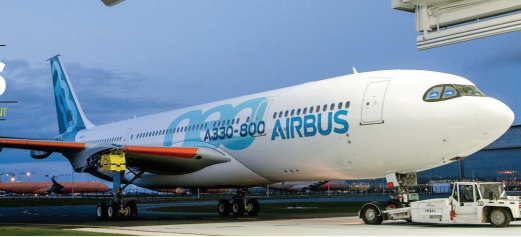
Aircraft might turn out to be difficult to maintain, finance and resell
Kampala, Uganda | ISAAC KHISA | On July 18, Uganda’s aviation sector marked a new beginning. The government signed agreements with two aircraft manufacturers, Airbus and Bombardier, for delivery of six airplanes during the Farnborough Air Show, ahead of the planned launch of a national carrier next year.
The Airbus is set to deliver A330-800 New Engine Option abbreviated as A300-800neo while Bombardier will deliver CRJ900.
But the announcement has elicited both excitement and questions in equal measure with regard to the choice of A300-800neo aircraft.
Launched at the Farnborough Airshow in 2014, the A330 neo aircraft is a replacement for A330-200, powered by new Rolls-Royce Trent 7000 engines and also features zero-splice nacelles, titanium pylons and new winglets.
While the aircraft was designed simultaneously with the A330-900 – the better-selling of the two, with 214 orders – the 800s have failed to attract buyers.
The 257 seater aircraft flies longer and at less fuel compared with the A330-900, although the latter carries 50 more passengers.
The sole customer -Hawaiian Airlines, which had ordered six A330-800s in 2014 as a strategy to replace its aging fleet cancelled the deal in March this year, in favour of Boeing 787-9s.
Hawaiian Airlines, which operates an existing version of the A330 on flights to Asia and the US, cited lack of interest for the aircraft by other carriers as the main reason for cancelling the deal. This followed previous cancellations of similar aircraft by TransAsia Airways before collapse.
The Boeing 787-9 is a stretched variant of the 787-8 aircraft. The aircraft, with a seating capacity suitable for 250-290 passengers, consumes 20% less fuel than any other aircraft in its class.
Experts said Hawaiian Airlines was trading cautiously arguing that managing such ‘orphan’ aircrafts is more difficult to maintain, finance and resell.
But Monica Azuba Ntege, the minister for works and transport insists that Uganda made the right choice following a careful analysis of technical and financial specifications of the companies that expressed interest.
She said government received proposals from Airbus, Bombardier, and Boeing but after careful analysis, they chose the first two.
She said the government has already paid US$400,000 to Bombardier and US$800,000 to Airbus to facilitate the aircraft manufacture. The government plans to purchase the A330s at US$293 million and CRJ’s at US$190 million each.
On cancellation of the A300-800 orders by earlier carriers, Azuba said there are many reasons as to why an airline may cancel an aircraft order.
“The change of order by the (Hawaiian) Airline was mainly on political grounds according to our sources,” she said.
She said the A330-800 variant will have a shorter fuselage (the main body of an aircraft) allowing it to fly longer and further than the current 900 version.
This performance, she says, will enable Uganda Airlines to operate non-stop flights on long routes to China and the Middle East.
Uganda’s move to revive the national carrier comes at the time the airline industry in Africa is projected to make a loss of US$100million this year, the same loss recorded in 2017, according to the International Air Transport Association (IATA).
“While traffic is growing, passenger load factors for African airlines are just over 70% which is over 10 percentage points lower than the industry average,” the report states in part.
“With high fixed costs, this low utilization makes it very difficult to make a profit. Stronger economic growth will help in 2018, but the continent’s governments need a concerted effort to further liberalise to promote growth of intra-Africa connectivity.”
In addition, competition is growing as other African countries revive their national carriers and plan major expansions.
For instance, Air Tanzania, which is barely two years in operation, plans to start direct flights from Dar es Salaam to Entebbe and Bujumbura later this month, the routes that have been dominated by Kenyan and Rwandan national carriers.
Air Tanzania said it will charge US$363 for a return ticket to Entebbe, flying on Monday, Wednesday, Friday and Sunday.
Its Bujumbura customers will pay US$358 for Tuesday, Thursday and Saturday flights. This is lower than the average of US$390 that travellers to Bujumbura and Dar es Salaam via Nairobi, Kigali or Addis Ababa pay, with an additional three to six hours connecting time.
Enter President Museveni
Plans to revive the national carrier gained momentum on Dec 31, 2016 when President Yoweri Museveni said in his New Year message that the government had finalised a plan to revive the carrier in a bid to ease travels in and out of the country and reduce on Ugandans’ expenditure on foreign airlines.
Started nearly four decades ago, the Uganda Airlines, then popularly known by its slogan ‘Flying Crane’, was liquidated by Museveni’s government in 2001 as a result of mismanagement and an accumulated debt of $6million.
Government officials argue that more Ugandans are now spending on air travel amounting to US$420million per annum and that it is time to tap into the sector.
Uganda’s international annual air traffic has grown more than 10 fold to 1.5million in 2017 and is projected to reach 7.6million by 2033, according to the sector regulator, Civil Aviation Authority.
 The Independent Uganda: You get the Truth we Pay the Price
The Independent Uganda: You get the Truth we Pay the Price



